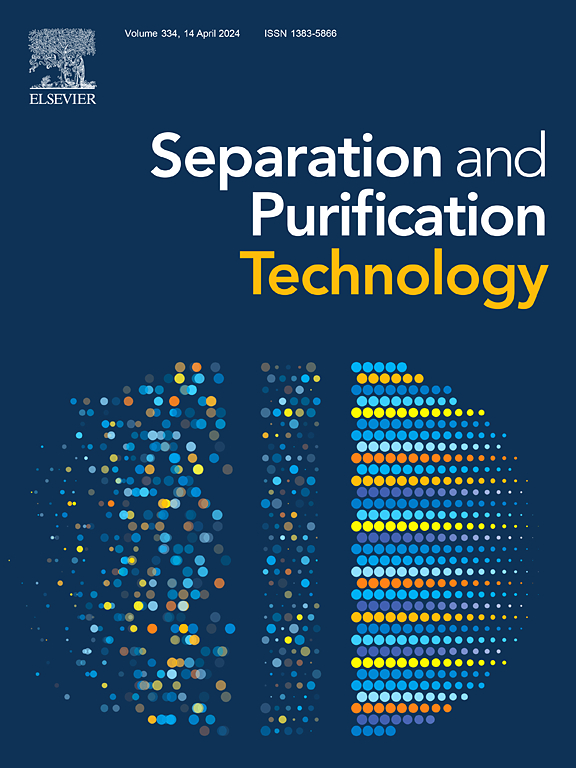Artificial humic acid mediated Fe(II) regeneration to restart Fe(III)/PMS for the degradation of atrazine
IF 8.1
1区 工程技术
Q1 ENGINEERING, CHEMICAL
引用次数: 0
Abstract
The degradation efficiency of organic contaminants using Fenton-like system based on Fe(II) and peroxymonosulfate (PMS) has been hindered by the rapid transformation from Fe(II) to Fe(III) and the slow regeneration of Fe(II). To address this challenge, artificial humic acid (AHA) derived from biomass was incorporated into Fe(III)/PMS system to build AHA/Fe(III)/PMS system. The results demonstrated that the degradation rate of atrazine (ATZ) in AHA/Fe(III)/PMS system (98.83%) is significantly superior to those in Fe(III)/PMS (16.51%) and AHA/PMS system (41.76%) within 90 min. Furthermore, Fe(II) measurement experiments revealed that AHA exhibited more significant iron-reducing potential. The analysis of FTIR, 3D-EEM, and liquid NMR indicated that AHA possessed more structures with reductive potential in comparison to commercial humic acid (CHA) and humic acid extracted from lignite (LHA). The results of persistent free radicals indicated that CHA possessed oxidative potential, which also accounted for the lowest Fe(II) concentration in those system containing CHA. Furthermore, quenching experiments, EPR analysis, and PMSO probe analysis have indicated the presence of reactive species such as •OH, SO4•-, and Fe(IV) within AHA/Fe(III)/PMS system. The degradation products from ATZ were identified and determined to exhibit reduced toxicity relative to parent compound. Collectively, these findings presented an in-depth understanding to reactivate Fe(III)/PMS system, offering a promising alternative strategy for efficient degradation of organic pollutants in water treatment processes.
人工腐殖酸介导的铁(II)再生重新启动铁(III)/PMS 降解阿特拉津的过程
由于从 Fe(II) 到 Fe(III) 的快速转化以及 Fe(II) 的缓慢再生,使用基于 Fe(II) 和过一硫酸盐 (PMS) 的 Fenton-like 系统降解有机污染物的效率受到了阻碍。为解决这一难题,研究人员将从生物质中提取的人工腐植酸(AHA)加入到 Fe(III)/PMS 系统中,构建了 AHA/Fe(III)/PMS 系统。结果表明,在 90 分钟内,AHA/Fe(III)/PMS 系统对阿特拉津(ATZ)的降解率(98.83%)明显优于 Fe(III)/PMS 系统(16.51%)和 AHA/PMS 系统(41.76%)。此外,Fe(II) 测量实验表明,AHA 表现出更明显的还原铁潜力。傅立叶变换红外光谱、三维电子显微镜和液体核磁共振分析表明,与商业腐植酸(CHA)和从褐煤中提取的腐植酸(LHA)相比,AHA 具有更多具有还原潜力的结构。持久自由基的研究结果表明,CHA 具有氧化潜能,这也是含有 CHA 的体系中铁(II)浓度最低的原因。此外,淬灭实验、EPR 分析和 PMSO 探针分析表明,AHA/Fe(III)/PMS 体系中存在活性物种,如 -OH、SO4-- 和 Fe(IV)。经鉴定,ATZ 的降解产物比母体化合物的毒性更低。总之,这些发现深入揭示了如何重新激活 Fe(III)/PMS 系统,为在水处理过程中高效降解有机污染物提供了一种前景广阔的替代策略。
本文章由计算机程序翻译,如有差异,请以英文原文为准。
求助全文
约1分钟内获得全文
求助全文
来源期刊

Separation and Purification Technology
工程技术-工程:化工
CiteScore
14.00
自引率
12.80%
发文量
2347
审稿时长
43 days
期刊介绍:
Separation and Purification Technology is a premier journal committed to sharing innovative methods for separation and purification in chemical and environmental engineering, encompassing both homogeneous solutions and heterogeneous mixtures. Our scope includes the separation and/or purification of liquids, vapors, and gases, as well as carbon capture and separation techniques. However, it's important to note that methods solely intended for analytical purposes are not within the scope of the journal. Additionally, disciplines such as soil science, polymer science, and metallurgy fall outside the purview of Separation and Purification Technology. Join us in advancing the field of separation and purification methods for sustainable solutions in chemical and environmental engineering.
 求助内容:
求助内容: 应助结果提醒方式:
应助结果提醒方式:


